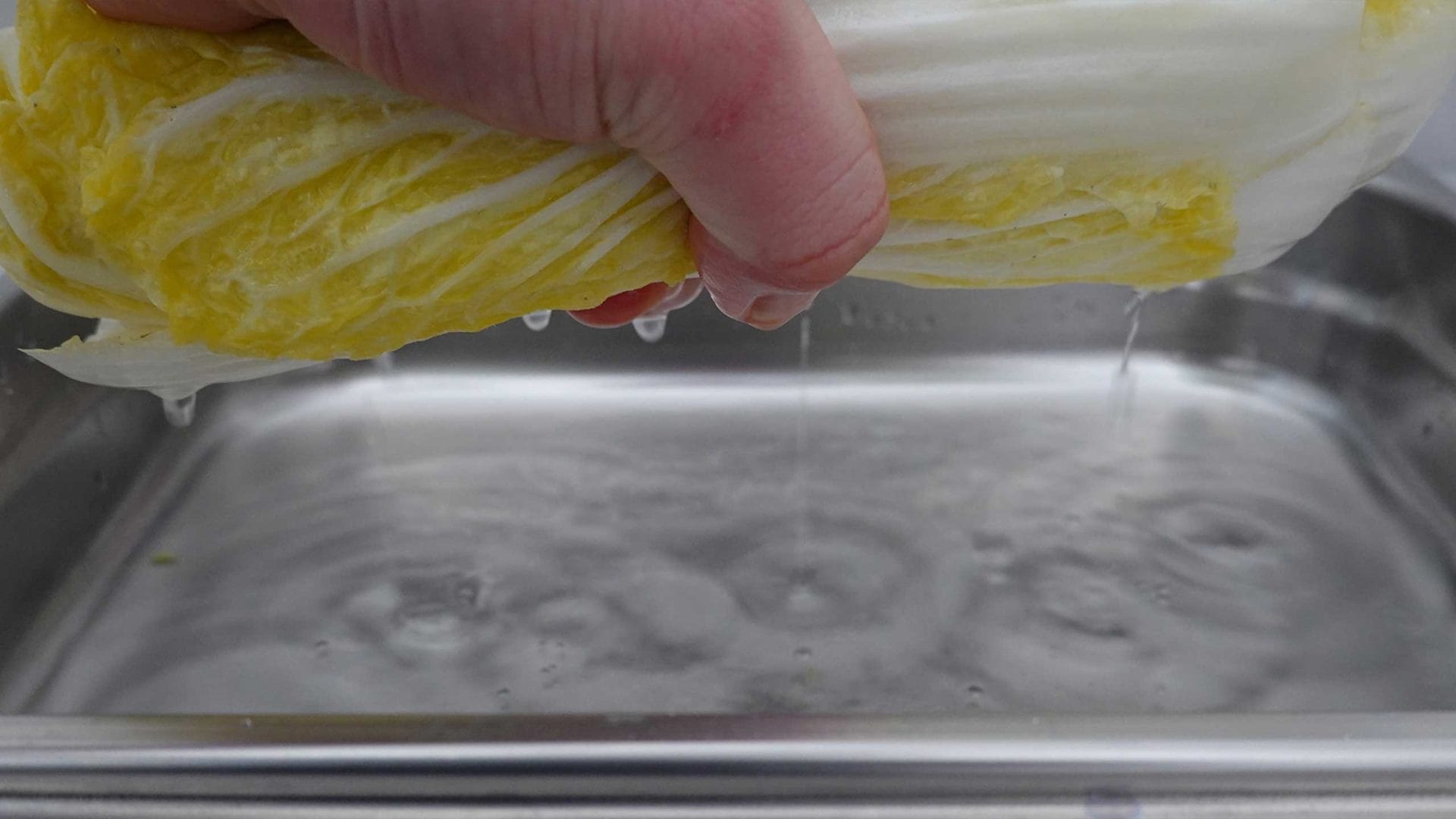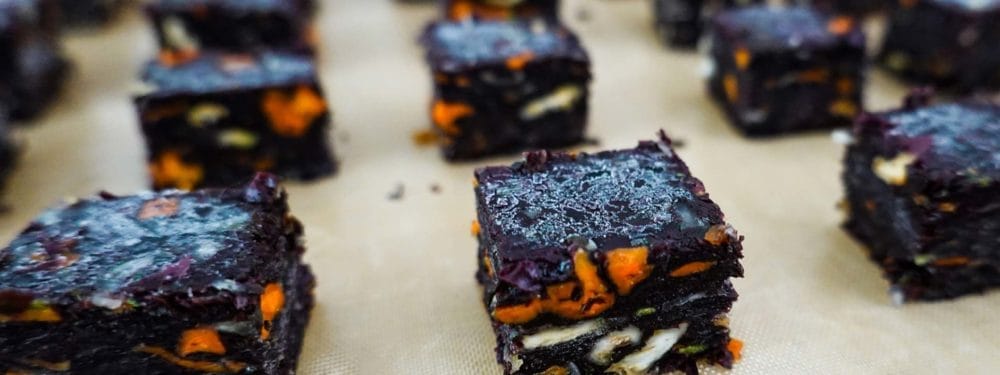Sauerkraut times differently: 3 times Kimchi
With the red charcoal experiments, we have already taken up the topic of herb. Instead of classic sauerkraut, we make Korean sauerkraut or German kimchi, which means we mix classic white cabbage with East Asian flavors, but also rutabaga and red cabbage are used in our versions.

1. rutabaga
Regardless of the ingredients or the country of origin, however, the basic idea always remains the same. Preserving vegetables or cabbage via fermentation and thus having very good tasting vitamins (especially A and C) in stock.
For this kimchi we use rutabaga and pear and some Chinese cabbage. The rutabaga has by nature, a very sweet taste. In addition, the tuber can score with vitamins B1, B2 and C. We cut the Chinese cabbage into its individual segments, sprinkle them with salt and stack the leaves on top of each other. During this process, which takes about 1.5 hours, we extract some of the water from the Chinese cabbage.
Carefully peel the rutabaga, cut it into large pieces and grate with the coarse side of the square slicer. This also gives us a larger surface area here. We leave the rutabaga as it is and do not add any additional salt.
For the paste we take onions, garlic, pears, roasted almonds, salt, paprika, ginger, a chili bell pepper and lemon juice. The pear brings a certain sweetness to the kimchi and thus sugar, which is food for the lactic acid bacteria and thus contributes to optimal fermentation. The almonds are rather unusual in a kimchi. We still had some of our nut spread with apple seeds, as we all know, that’s how the best recipes come about!

All ingredients are now finely mixed with a little old soy sauce for 2-3 minutes. The result is a balanced deep red seasoning paste. We squeeze the salted Chinese cabbage vigorously so that it loses the excess water. We slice our chilies finely, grate the overripe pears down coarsely, add almonds as toasted sticks. We cut the salted, squeezed Chinese cabbage into wide strips. We mix all the ingredients in a deep tray, here we carefully massage the seasoning paste.
After we have rubbed everything, a part is put into a commercial jar, which we have previously rinsed with boiling water. Here it should be noted that you press the cabbage, with pressure into the glass, so air pockets disappear. We vacuum the remaining cabbage, on day 5 we can observe how the bag slowly inflates, the power of nature shows its effect. Only through the work of small microorganisms carbon dioxide is produced from sugar and oxygen. On the seventh day, we can see a clear distension of the pouch. On day 8, we refrigerate the kimchi at 3°C and let it ripen for another few days. When opening the rutabaga kimchi, we are met by a smell that reminds us of coleslaw with a slight hint of garlic. The kimchi is slightly soupy and looks like sauerkraut. The almonds have soaked up the broth, but retain some nuttiness. The spiciness was mitigated by fermentation. We really like the rutabaga kimchi!
2. red cabbage kimchi
Since our January project “Cabbage” we are very fond of red cabbage. Hence the idea now also to prepare a red cabbage kimchi.
For this we cut the red cabbage into coarse pieces, in order to release some of the water from this cabbage as well, we salt it heavily. Cover and leave the cabbage at room temperature for 1.5 hours. In between we mix it 2 times, because the cabbage by nature has a very thick-solid structure. For our spice paste we fillet an orange and cut ginger and apple into coarse pieces. We mix these ingredients and a little of our honey vigorously. As another ingredient for the kimchi, we roughly grate down apple, radish and carrots.

The cabbage has lost a lot of water after salting, we squeeze it extra and then put it in a deep container with the rest of the shaved ingredients.

Typical spices for red cabbage are bay leaf, cinnamon sticks and garlic. We also use these and mortar them. Then we add the seasoning paste to the cabbage and massage it in thoroughly. In the following step we add the mortared spices. Some of the kimchi mixture is put into a jar rinsed with boiling water, and the rest we put into a vacuum bag. You can observe on day 5 how the lactic acid bacteria work and the vacuum bag slowly inflates. Surprisingly, the bag of red cabbage kimchi did not swell as much as that of rutabaga or white cabbage. On day 12, we open the jar for the first time. The red cabbage kimchi is very fruity in smell, that has filigree traces of a perfume. It is crunchy-firm to the bite, the strong flavor has been greatly reduced by fermentation. We let this kimchi mature a little further. After all, there is still some time until Christmas – although we can also imagine this mildly fruity red cabbage version very well as a light summer cabbage.
3. white cabbage
For our kimchi, we first cut the white cabbage into coarse strips. Thus, we gain a larger surface area in the cabbage. This gives salt and spices a better chance to penetrate. Korean kimchi is prepared with Chinese cabbage, we use the typical German white cabbage. This we salt vigorously. The cabbage thus dehydrates and can better absorb the seasoning paste. This process takes about 1 hour. During this time we prepare the paste. It gives the kimchi its typical taste and is an essential difference to our sauerkraut, which is rather restrained in its seasoning.
For the paste, we chop red and green chilies, lemon zest, pineapple, ginger, leeks, onion, garlic and carrots. The various ingredients are mixed into a fine paste with the addition of fish sauce, chili flakes and smoked paprika. Opening the mixing cup, we already perceive the fruitiness of the pineapple, a slight smell of onion paired with the smoky scent of the paprika powder. The salted white cabbage we squeeze vigorously. We put this and the other prepared ingredients in a deep tray to mix with the aromatic paste. This must be done very cleanly to guarantee a smooth fermentation. Impurities can lead to inedible results.

Lactic acid without milk? Science!
During fermentation, the fructose in the pineapple is broken down by the work of lactic acid bacteria to lactic acid and carbon dioxide (CO2). After massaging all the ingredients vigorously with the paste, a portion is placed in a commercial jar, which we have previously rinsed in boiling water to minimize the influence of unwanted bacteria. The other part we leave to ferment under vacuum. In the vacuum process, the formation of carbon dioxide (CO2) can be observed very well later. The kimchi is now at an average temperature of 18.2 °C for the next 5-7 days in the FoodLab. It then goes into refrigeration and matures there for another few days. Here you can clearly observe how the work of the lactic acid bacteria inflates the bag. On day 12, we open the glass for the first time, a strong hiss is heard and a sour and pungent smell comes towards us. Many small gas bubbles rise at the edge of the glass. The taste test thrilled us: slightly spicy, tart but still very crisp in texture.






